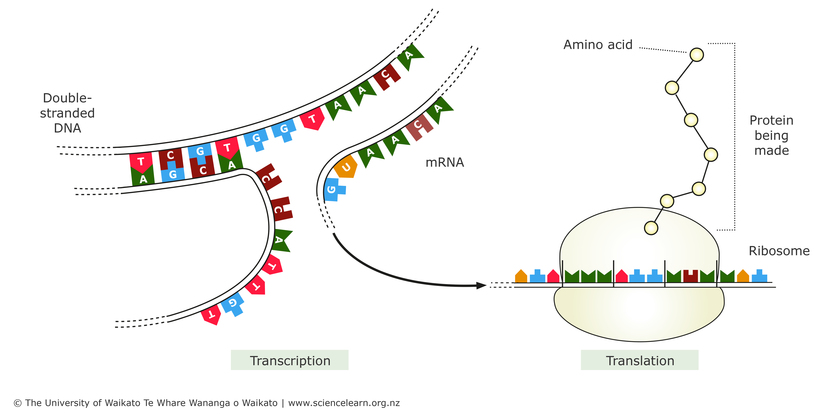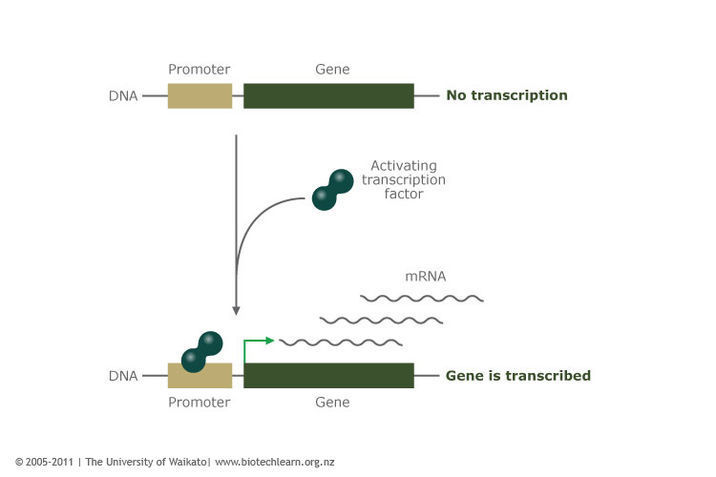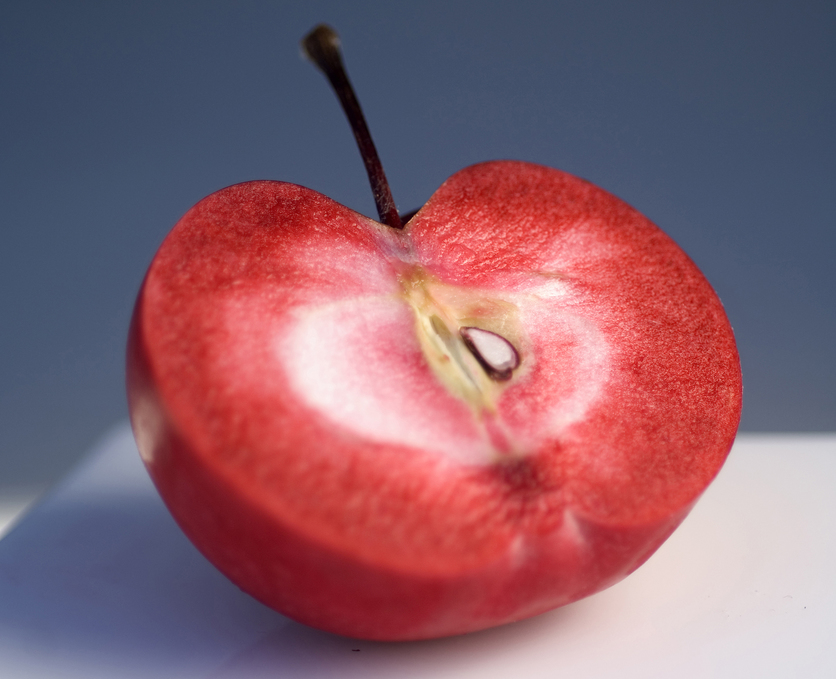Proteins are the key working molecules and building blocks in all cells. They are produced in a similar two-step process in all organisms called protein synthesis – DNA is first transcribed into RNA, then RNA is translated into protein.
Upstream of individual genes, sequences of DNA called promoters determine when proteins are produced and in what amounts.
What is a protein?
Proteins are the major ‘working molecules’ within every organism. Among their many jobs, proteins catalyse reactions, transport oxygen and defend organisms from infection. They’re also crucial building blocks of organisms. They are the major components of wool, cartilage and milk, they package up the DNA in chromosomes and they insulate the cells of the nervous system. In short, proteins are hugely important!
Proteins are made of large numbers of amino acids joined end to end. The chains fold up to form three-dimensional molecules with complex shapes – you could think of it as origami with a very long and thin piece of paper. The precise shape of each protein, along with the amino acids it contains, determines what it does.
Proteins: key examples on the Hub
Enzymes are proteins. Many enzymes have useful applications in medical or industrial biotechnology. Find out more in the video clip: Improving enzymes.
The article Catalysing chemical reactions with enzymes includes an animated video outlining in detail how enzymes work.
Insulin is a protein that regulates blood glucose. Type 1 diabetics do not produce insulin. Find out more in the video clip: Type 1 diabetes.
Mussels hold fast to rocks and piles using their strong byssal threads, which are made of protein. Find out more in the interactive: How mussels are farmed in New Zealand.
Antibodies are proteins, find out more in the article: The immune system.
Casein is the protein in milk that is used to make cheese. Find out more in the animated video: Cheese: a molecular view.
Transcription factors are specialised proteins that control the production of other proteins. Find out more in the video clip: What controls apple flesh colour?.
The macrofibrils within wool are made of protein. Find out more in the interactive: Wool fibre structures and properties.
Understand how scientists were able to identify enzymes to correlate the presence of plastic degrading marine microorganisms and plastic pollution.
Proteins are expressed from genes
All organisms make proteins in essentially the same way. The process starts with a gene – the ‘instruction manual’ for constructing the protein. For this reason, the process of making a protein is also called gene expression.
Gene expression has two main stages: transcription and translation.
Transcription
Structures in the cell identify the start and end of a gene and read the DNA sequence between them (the order of A, C, G and T bases within the gene). A molecular message (an mRNA molecule) is produced that echoes the sequence of the gene itself. In most respects, mRNA looks similar to a single-stranded piece of DNA.
Translation
A ribosome receives the mRNA molecule and starts to build a chain of amino acids (a protein) that exactly matches the instructions within the mRNA. The ribosome ‘reads’ the mRNA sequence as a series of three-base chunks or codons. Each codon tells the protein-making machinery which amino acid to add next.
The genetic code is essentially the same throughout nature
Remarkably, across all life, each codon has the same ‘meaning’ in any given cell (with a few minor exceptions). For instance, the codon AGA is an instruction to add the amino acid arginine to a growing protein – whether that protein is growing within bacterial cells or human cells. In other words, every cell follows the same rules to make a new protein.
See the article How to add foreign DNA to bacteria for more information.
Which proteins are made when – the power of a promoter
Within any cell, only a proportion of proteins are produced at any one time. Proteins that perform essential roles are produced constantly, while others are expressed only when they are needed. Cells also need large amounts of some proteins (such as the enzymes involved in continuous processes like transcription and translation) and smaller amounts of others (such as hormones). But how does a cell decide which genes to express and how much to make?
Promoters are the sequences of DNA that determine when a gene is expressed. These sections of DNA sit in front of genes and provide a ‘landing site’ for transcription factors (proteins that switch gene expression on and off) and RNA polymerase (the protein that reads DNA and makes an mRNA copy). Different promoter sequences have different strengths, and genes with ‘strong’ promoters are expressed at a higher level than those with ‘weak’ promoters.
Promoters and apple flesh colour
At Plant & Food Research, Richard Espley and colleagues are exploring the role of promoters in determining whether apples have white or red flesh. The group found a transcription factor (MYB10) that binds to the promoter of several genes that produce red pigment in apples, causing them to be expressed. There is far more MYB10 in red-fleshed apples than in white-fleshed apples, so these pigment genes are expressed at a higher level and make more red pigment.
Find out more in the article: Discovering what controls apple flesh colour.
Proteins and gene expression
These articles have further information about gene expression and proteins.
Useful link
Explore the range of resources from the Genetic Science Learning Center at The University of Utah, including interactives.




